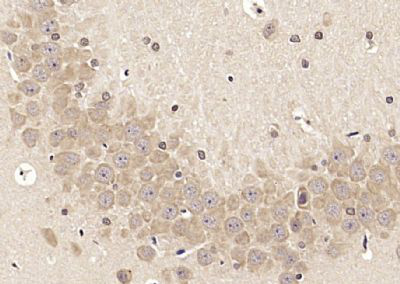产品货号 : mlR11087
英文名称 : LRFN2
中文名称 : 神经突触粘附样分子1抗体
别 名 : leucine rich repeat and fibronectin type III domain containing 2; RP11-535K1.2; fibronectin type III, immunoglobulin and leucine rich repeat domains 2 antibody FIGLER2; Leucine-rich repeat and fibronectin type-III domain-containing protein 2; LRFN2; LRFN2_HUMAN; SALM1; Synaptic adhesion-like molecule 1.
研究领域 : 神经生物学 信号转导 细胞粘附分子
抗体来源 : Rabbit
克隆类型 : Polyclonal
交叉反应 : Human, Mouse, Rat, Chicken, Dog, Pig, Cow, Horse, Rabbit, Sheep,
产品应用 : WB=1:500-2000 ELISA=1:500-1000 IHC-P=1:400-800 IHC-F=1:400-800 ICC=1:100-500 IF=1:100-500 (石蜡切片需做抗原修复)
not yet tested in other applications.
optimal dilutions/concentrations should be determined by the end user.
分 子 量 : 83kDa
细胞定位 : 细胞膜
性 状 : Lyophilized or Liquid
浓 度 : 1mg/ml
免 疫 原 : KLH conjugated synthetic peptide derived from human LRFN2/SALM1:401-500/789 <Extracellular>
亚 型 : IgG
纯化方法 : affinity purified by Protein A
储 存 液 : 0.01M TBS(pH7.4) with 1% BSA, 0.03% Proclin300 and 50% Glycerol.
保存条件 : Store at -20 °C for one year. Avoid repeated freeze/thaw cycles. The lyophilized antibody is stable at room temperature for at least one month and for greater than a year when kept at -20°C. When reconstituted in sterile pH 7.4 0.01M PBS or diluent of antibody the antibody is stable for at least two weeks at 2-4 °C.
PubMed : PubMed
产品介绍 : LRFN2 is a 789 amino acid single-pass type I membrane protein belonging to the LRFN family. Encoded by a gene that maps to human chromosome 6p21.2, LRFN2 is moderately expressed in brain, spleen and testis. LRFN2 contains one fibronectin type-III domain, one Ig-like (immunoglobulin-like) domain and six LRR (leucine-rich) repeats. LRFN2 promotes neurite outgrowth in hippocampal neurons, enhances cell surface expression of two NMDA receptor subunits, NMDAΩ1 and NMDAé1, and may play a role in redistributing PSD-95 to cell periphery. LRFN2 forms heteromeric complexes with LRFN1, LRFN3, LRFN4 and LRFN5, and is capable of forming homomeric complexes, but not across cell junctions.
Function:
Promotes neurite outgrowth in hippocampal neurons. Enhances the cell surface expression of 2 NMDA receptor subunits GRIN1 and GRIN2A. May play a role in redistributing DLG4 to the cell periphery.
Subunit:
Forms heteromeric complexes with LRFN1, LRFN3, LRFN4 and LRFN5. Can form homomeric complexes, but not across cell junctions. Directly interacts with 2 NMDA receptor subunits GRIN1 and GRIN2A (By similarity). Interacts with DLG1, DLG2, DLG3 and DLG4.
Subcellular Location:
Membrane. Cell junction; synapse. Cell junction; synapse; postsynaptic cell membrane.
Post-translational modifications:
Glycosylated.
Similarity:
Belongs to the LRFN family.
Contains 1 fibronectin type-III domain.
Contains 1 Ig-like (immunoglobulin-like) domain.
Contains 7 LRR (leucine-rich) repeats.
Contains 1 LRRCT domain.
Contains 1 LRRNT domain.
SWISS:
Q9ULH4
Gene ID:
57497
Important Note:
This product as supplied is intended for research use only, not for use in human, therapeutic or diagnostic applications.
产品图片












